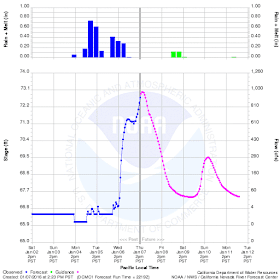We've had rain, finally, in amounts that might make some small dent in the drought that has plagued California for nearly five years. I was headed into work and crossed Dry Creek in the Waterford area. Something was different: the creek was flooding. Not a vast flood, not one likely to produce widespread damage, but still, the banks and some of the oak tree trunks were underwater. It was a shock to see so much water after literally years of dry channels under this bridge.
Dry Creek (who comes up with these imaginative names?) heads in the lower foothills of the Sierra Nevada, so it is never fed by melting snowpack. Peak runoff occurs instead during intense rainstorm events. The creek flows into the Central Valley near Waterford and eventually joins the Tuolumne River at Modesto, for a total length of about 60 miles. It no doubt earned the name "Dry" a century ago, but in more recent years water flowed in the creek most of the time due to irrigation runoff. And during the drought of the last four years, it has been dry for months at a time, once again earning its name.
There have not been many floods during the drought years. The soil has been so parched that what little rain fell soaked into the ground, leaving little for surface runoff. The 2015-2016 water year has been different. November and December provided above-normal rainfall (and a Sierra snowpack), so when the January storms hit this week (the first attributed to El Nino), the ground was pretty well saturated. Close to 2 inches fell over the region on Tuesday and Wednesday, and the river peaked today at almost 1,000 cubic feet per second. As can be seen on the flood hydrograph below, the river will recede relatively quickly to tens of cubic feet per second within a day or so.
The last time Dry Creek really caught my attention this way was back in March 2011, when the discharge was around three times higher than it was today, at 3,000 cubic feet per second. Compare the difference in the picture below, taken from the same bridge. The river was even higher in the El Nino year of 1997, and with a probability of once in 500 years the creek may produce flows as great as 18,500 cubic feet per second. That would be something to see, but I wouldn't wish it on anyone.
 |
| Dry Creek in March 2011 |
Seeing these two different things reminded me that there is a small remnant of a natural ecosystem left in our valley, one that can never be completely obliterated by dams, farms, and cities. We can never truly control the rivers or droughts, and the tattered remnants of the original ecosystem will for the most part adapt and survive our invasion, albeit in small pockets here and there.




Wonderful. Nothing better than the rare smell of moisture during a drought.
ReplyDelete